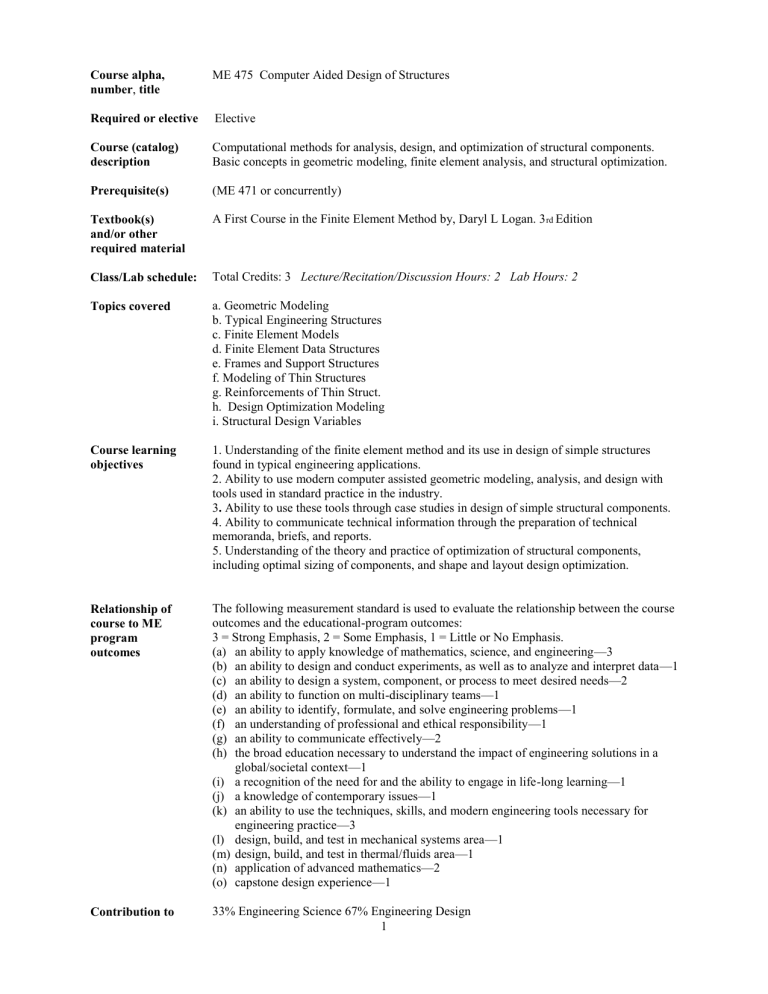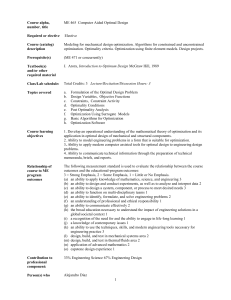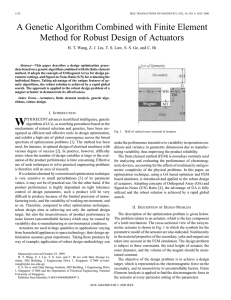ME 475 Outline.doc

Course alpha, number , title
ME 475 Computer Aided Design of Structures
Required or elective Elective
Course (catalog) description
Computational methods for analysis, design, and optimization of structural components.
Basic concepts in geometric modeling, finite element analysis, and structural optimization.
Prerequisite(s) (ME 471 or concurrently)
Textbook(s) and/or other
A First Course in the Finite Element Method by, Daryl L Logan. 3 rd
Edition required material
Class/Lab schedule: Total Credits: 3 Lecture/Recitation/Discussion Hours: 2 Lab Hours: 2
Topics covered a. Geometric Modeling b. Typical Engineering Structures c. Finite Element Models d. Finite Element Data Structures e. Frames and Support Structures
Course learning objectives
Relationship of course to ME program outcomes
Contribution to f. Modeling of Thin Structures g. Reinforcements of Thin Struct. h. Design Optimization Modeling i. Structural Design Variables
1. Understanding of the finite element method and its use in design of simple structures found in typical engineering applications.
2. Ability to use modern computer assisted geometric modeling, analysis, and design with tools used in standard practice in the industry.
3 . Ability to use these tools through case studies in design of simple structural components.
4. Ability to communicate technical information through the preparation of technical memoranda, briefs, and reports.
5. Understanding of the theory and practice of optimization of structural components, including optimal sizing of components, and shape and layout design optimization.
The following measurement standard is used to evaluate the relationship between the course outcomes and the educational-program outcomes:
3 = Strong Emphasis, 2 = Some Emphasis, 1 = Little or No Emphasis.
(a) an ability to apply knowledge of mathematics, science, and engineering—3
(b) an ability to design and conduct experiments, as well as to analyze and interpret data—1
(c) an ability to design a system, component, or process to meet desired needs—2
(d) an ability to function on multi-disciplinary teams—1
(e) an ability to identify, formulate, and solve engineering problems—1
(f) an understanding of professional and ethical responsibility—1
(g) an ability to communicate effectively—2
(h) the broad education necessary to understand the impact of engineering solutions in a global/societal context—1
(i) a recognition of the need for and the ability to engage in life-long learning—1
(j) a knowledge of contemporary issues—1
(k) an ability to use the techniques, skills, and modern engineering tools necessary for engineering practice—3
(l) design, build, and test in mechanical systems area—1
(m) design, build, and test in thermal/fluids area—1
(n) application of advanced mathematics—2
(o) capstone design experience—1
33% Engineering Science 67% Engineering Design
1
professional component:
Person(s) who prepared this description
Date of
Preparation
Alejandro Diaz
7 April 2004
2



